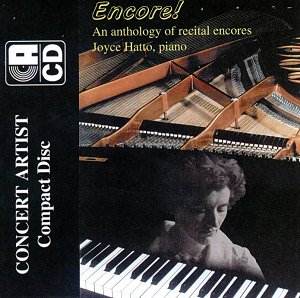AVAILABILITY
www.concertartistrecordings.com
It’s good to see that
Joyce Hatto can let her hair down for
Concert Artist. This is the first volume
in what looks like a series and I’m
sure that the next volume will be as
creatively and imaginatively selected
as this one. It has hallmarks of Golden
Age pianism – with Weber, Moszkowski
and plenty of virtuoso hyphenation on
board – as well as highlighting Hatto’s
well-known strengths in the Francophile
and Russian repertoires. So there’s
plenty to stimulate the ear and an incidental
and by no means unpleasurable by-product
has been to send me scurrying to my
shelves to listen to the very pianists
for whom this repertoire was encore
fodder on shellac in the 1920s and 1930s.
Here are a few highlights
and thoughts then. Moszkowski’s Caprice
espagnole was a Hoffman speciality but
it was also something essayed by a pianist
cut from rather craggier cloth, Wilhelm
Backhaus. Hatto is full of energy here,
charmingly pointed, witty and articulate
with trademark passagework precision;
I especially like the way she turns
the elegant rococo of the central section.
Backhaus by contrast tends to make heavier
weather of it in his 1923 HMV – less
fluent and fleet. Her Schubert-Tausig
Marche Militaire is not rip-roaringly
animated – rather it’s quite serious
with great delicacy in the contrastive
sections. Levitzki turned it into a
tumult of heavy left hand accents and
galloping vigour with a quipping central
section. Her Schubert-Liszt Hark, Hark
the Lark is one of those pieces everyone
played, even violinists. Compared with
Friedman’s characterisation and volatile
pianism or the young Arrau’s more vocalised
impress Hatto does tend to be straighter
though maybe the rather smooth and unlingering
tempo militates against her.
She is characteristically
powerful and impressive in Rachmaninov’s
Vocalise, abjuring sentimentality. Kissin
brings out the left hand melodies better
but he plays a simplified arrangement
on his RCA disc and I wouldn’t recommend
him. Her Schumann Widmung has simplicity
and generosity a-plenty – Backhaus mixes
up the voicings in a much quicker and
purely pianistic reading – but she is
relatively slow whilst her Grieg playing
is both delicate and wittily phrased,
as is her Debussy. I’ve never thought
Rachmaninov’s arrangement of his colleague
Fritz Kreisler’s Liebesleid really works
and fine though her playing is, Joyce
Hatto can’t convince me of it either.
This set makes for
an attractive pendant to her more heavyweight
literature on the Concert Artist label.
The notes are entertaining and the programme
well worth the revival.
Jonathan Woolf
see also JOYCE
HATTO - A Pianist of Extraordinary Personality
and Promise Comment
and Interview by Burnett James
The
entire Concert Artists catalogue is
available through MusicWeb

